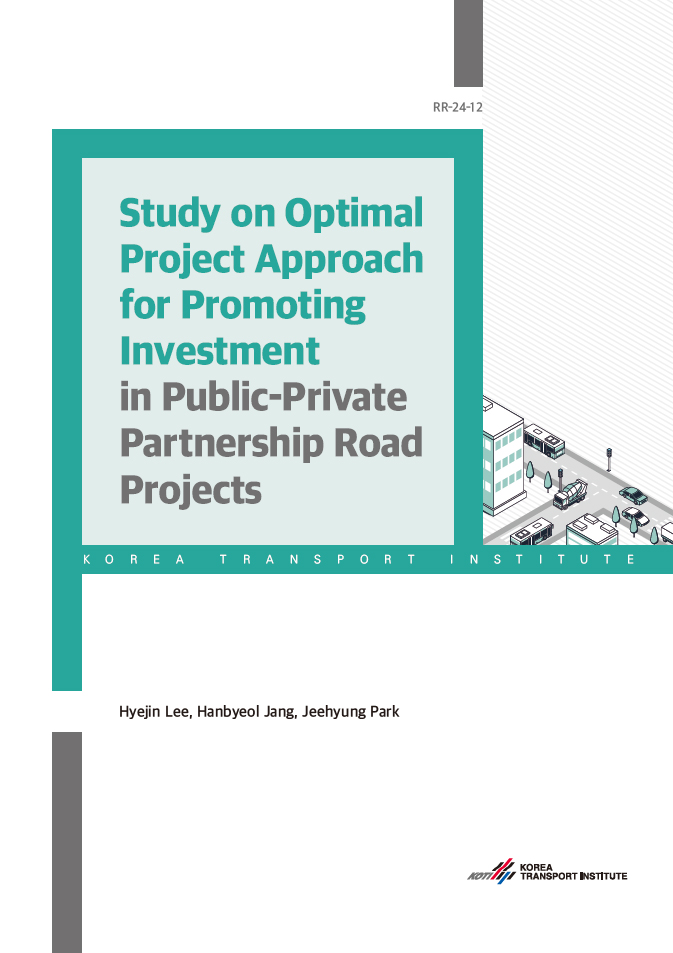Basic Report

RESEARCH
KOTI - Korea Transport institute
Study on Optimal Project Approach for Promoting Investment in Public-Private Partnership Road Projects
- Date
July 01 2025
- Authors
Hyejin Lee, Hanbyeol Jang, Jeehyung Park
- Page(s)
10 page(s)

1. Introduction
A. Motivation and objective
Since 2015, the Korean government has promoted private investment in road infrastructure by introducing various delivery methods for public-private partnership (PPP) projects, as shown in Table 1. These efforts aim to distribute project risks between the public and private sectors based on the characteristics of each road project. However, despite continued institutional efforts, the absence of a decision-making tool to evaluate the risk-sharing structure of each delivery method has hindered the adoption of various approaches.
To address these issues, this study proposes the use of Robust Decision Making (RDM) to evaluate the delivery methods of PPP road projects. The proposed model offers a framework to assess the vulnerability and robustness of road projects in the face of future risks using project return rates as a key reference indicator.
B. Methodology
This research covers a total of 34 PPP road projects—including national expressways and local government roads—as of the end of 2023. This research defines the correlation between the rates of return and risk groups of projects by robust regression analysis. RDM is incorporated for a decision-making framework.
2. Conclusion
This study is based on the premise that one of the main obstacles to promoting public-private partnership (PPP) road projects is the rigid structure used to determine the agreed rate of return. The research proposes a project delivery method determination model that reflects the specific characteristics of each project. The proposed decision-making framework incorporates Robust Decision Making (RDM) to quantify project-related uncertainty and assist the government in identifying the most resilient strategies under such conditions.
The current return determination structure, which fails to flexibly account for the level of risk borne by the private sector, acts as a barrier to the application of various project delivery models. Government risk sharing is treated merely as a sub-factor of the expected return, which contrasts with previous studies that recognize risk sharing as a key determinant of project performance. A balanced allocation of responsibilities between the public and private sectors is essential to establish a sustainable PPP structure for road projects. This research would support the government in identifying PPP road projects that align with policy objectives while appropriately accounting for long-term risk.
A. Motivation and objective
Since 2015, the Korean government has promoted private investment in road infrastructure by introducing various delivery methods for public-private partnership (PPP) projects, as shown in Table 1. These efforts aim to distribute project risks between the public and private sectors based on the characteristics of each road project. However, despite continued institutional efforts, the absence of a decision-making tool to evaluate the risk-sharing structure of each delivery method has hindered the adoption of various approaches.
To address these issues, this study proposes the use of Robust Decision Making (RDM) to evaluate the delivery methods of PPP road projects. The proposed model offers a framework to assess the vulnerability and robustness of road projects in the face of future risks using project return rates as a key reference indicator.
B. Methodology
This research covers a total of 34 PPP road projects—including national expressways and local government roads—as of the end of 2023. This research defines the correlation between the rates of return and risk groups of projects by robust regression analysis. RDM is incorporated for a decision-making framework.
2. Conclusion
This study is based on the premise that one of the main obstacles to promoting public-private partnership (PPP) road projects is the rigid structure used to determine the agreed rate of return. The research proposes a project delivery method determination model that reflects the specific characteristics of each project. The proposed decision-making framework incorporates Robust Decision Making (RDM) to quantify project-related uncertainty and assist the government in identifying the most resilient strategies under such conditions.
The current return determination structure, which fails to flexibly account for the level of risk borne by the private sector, acts as a barrier to the application of various project delivery models. Government risk sharing is treated merely as a sub-factor of the expected return, which contrasts with previous studies that recognize risk sharing as a key determinant of project performance. A balanced allocation of responsibilities between the public and private sectors is essential to establish a sustainable PPP structure for road projects. This research would support the government in identifying PPP road projects that align with policy objectives while appropriately accounting for long-term risk.
[ Contents ]
1. Introduction
2. Main Contents of Research
3.Conclusion
1. Introduction
2. Main Contents of Research
3.Conclusion